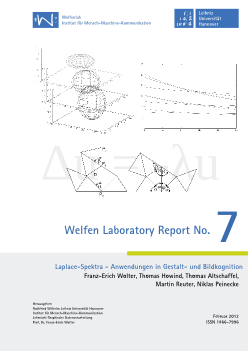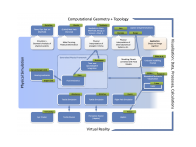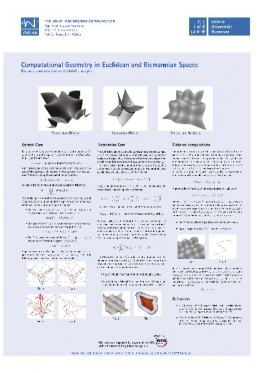Publikationen
Welfenlab Reports
Durch unsere Veröffentlichungsreihe Welfen Laboratory Reports informieren wir über Forschungsarbeiten an unserem Lehrstuhl, unter anderem werden auf diesem Weg ausgewählte studentische Abschlussarbeiten publiziert.
Publikationen nach Jahren
Hier finden sie sämtliche Publikationen des Welfenlab geordnet nach Art der Publikation und Erscheinungsdatum.
Sie finden hier auch ein vollständige Publikationsliste.
| 1979 . . . 2009 | 2010 | 2011 | 2012 | 2013 | 2014 | 2015 | 2016 |
2015
| Artikel |
| 2015 |
Hannes Thielhelm, Alexander Vais, Franz-Erich Wolter Geodesic bifurcation on smooth surfaces The Visual Computer 31 187-204 Springer-Verlag Berlin Heidelberg 2015 Beschreibungstext anzeigen Within Riemannian geometry the geodesic exponential map is an essential tool for various distance-related investigations and computations. Several natural questions can be formulated in terms of its preimages, usually leading to quite challenging non-linear problems. In this context we recently proposed an approach for computing multiple geodesics connecting two arbitrary points on two-dimensional surfaces in situations where an ambiguity of these connecting geodesics is indicated by the presence of focal curves. The essence of the approach consists in exploiting the structure of the associated focal curve and using a suitable curve for a homotopy algorithm to collect the geodesic connections. In this follow-up discussion we extend those constructions to overcome a significant limitation inherent in the previous method, i.e. the necessity to construct homotopy curves artificially. We show that considering homotopy curves meet- ing a focal curve tangentially leads to a singularity that we investigate thoroughly. Solving this so-called geodesic bifurcation analytically and dealing with it numerically provides not only theoretical insights, but also allows geodesics to be used as homotopy curves. This yields a stable computational tool in the context of computing distances. This is applicable in common situations where there is a curvature induced non-injectivity of the exponential map. In particular we illustrate how applying geodesic bifurcation approaches the distance problem on compact manifolds with a single closed focal curve. Furthermore, the presented investigations pro- vide natural initial values for computing cut loci using the medial differential equation which directly leads to a discussion on avoiding redundant computations by combining the presented concepts to determine branching points. Link: http://link.springer.com/article/10.1007/s00371-014-1041-3/fulltext.html |
Martin Gutschke, Alexander Vais, Franz-Erich Wolter Differential geometric methods for examining the dynamics of slow-fast vector fields The Visual Computer 31 169-186 Springer-Verlag Berlin Heidelberg 2015 Beschreibungstext anzeigen In this work we present computational methods for examining dynamical systems. We focus on those systems being characterized by slow–fast vector fields or corresponding differential algebraic equations that commonly occur in physical applications. In the latter ones scientists usually consider a manifold of admissible physical states and a vector field describing the time evolution of the physical system. The manifold is typically implicitly defined within a higher-dimensional space by a system of equations. Certain physical systems, such as relaxation oscillators, perform sudden jumps in their state evolution when they are forced into an unstable state. The main contribution of the present work is to model the dynamical evolution incorporating the jumping behavior from a perspective of computational geometry which not only provides a qualitative analysis but also produces quantitative results. We use geodesic polar coordinates (GPC) to numerically obtain explicit parametrizations of the implicitly defined manifold and of the relevant jump and hit sets. Moreover, to deal with the possibly high co-dimension of the considered implicitly defined manifold we sketch how GPC in combination with the cut locus concept can be used to numerically obtain an essentially injective global parametrization. This allows us to parametrize and visualize the dynamical evolution of the system including the aforementioned jump phenomena. As main tools we use homotopy approaches in conjunction with concepts from differential geometry. We discuss how to numerically realize and how to apply them to several examples from mechanics, electrical engineering and biology. Link: http://link.springer.com/article/10.1007/s00371-014-1036-0/fulltext.html |
Benjamin Berger, Alexander Vais, Franz-Erich Wolter Subimage sensitive eigenvalue spectra for image comparison The Visual Computer 31 205-221 Springer-Verlag Berlin Heidelberg 2015 Beschreibungstext anzeigen This publication is a contribution to basic research in image comparison using eigenvalue spectra as features. The differential-geometric approach of eigenvalue spectrum-based descriptors is naturally applicable to shape data, but so far little work has been done to transfer it to the setting of image data painted on a rectangle or general curved surface. We present a new semi-global feature descriptor that also contains information about geometry of shapes visible in the image. This may not only improve the performance of the resulting distance measures, but may even enable us to approach the partial matching problem using eigenvalue spectra, which were previously only considered as global feature descriptors. We introduce some concepts that are useful in designing and understanding the behaviour of similar fingerprinting algorithms for images (and surfaces) and discuss some preliminary results. Link: http://link.springer.com/article/10.1007/s00371-014-1038-y/fulltext.html |
Ricardo Manuel Millan Vaquero, Sean Dean Lynch, Benjamin Fleischer, Jan Rzepecki, Karl-Ingo Friese, Christof Hurschler, Franz-Erich Wolter Enhanced Visualization of the Knee Joint Functional Articulation Based on Helical Axis Method Bildverarbeitung für die Medizin 2015, Informatik aktuell 2015 449-454 Springer Berlin Heidelberg 2015 Beschreibungstext anzeigen Comprehensive descriptions of the motion in articulating joints open new opportunities in biomedical engineering. The helical axis is a established method that describes flexion-extension at joints, which currently lacks an intuitive visualization. In this paper, we present a comprehensive visualization of knee joint motion based on a direct measurement of the helical axis. The proposed approach incorporates the three-dimensional motion of patient-specific bone segments and the representation of helical axes on the bone, facilitating the observation of the flexion-extension motion at the knee joint. |
Matthias Becker, Karl-Ingo Friese, Franz-Erich Wolter, Nils-Claudius Gellrich, Harald Essig Development of a Reliable Method for Orbit Segmentation & Measuring IEEE International Symposium on Medical Measurements and Applications (MeMeA 2015) 285-290 2015 Beschreibungstext anzeigen Injuries of the bony orbit that, which contains the eye, not only have aesthetic implications but also impair stereoscopic vision. Different techniques are used for surgical treatment. In this work we will present a tool that allows the reliable segmentation of the reconstructed and the unaffected orbit. For this we present a novel anterior closing that follows the clinical understanding of anatomy. To assist in the post-surgical evaluation, we suggest parameters with respect to clinically relevant regions (orbital floor, medial wall) and demonstrate a method to automatically determine them. We evaluate our methods on clinical cases. Date: May, 7, 2015 |
F.-E. Wolter Short Overview on Welfenlab Research (Spring 2015) 2015 Beschreibungstext anzeigen This document summarizes the current lines of research at Welfenlab, including links to the references. |
Ricardo Manuel Millan Vaquero, Alexander Vais, Sean Dean Lynch, Jan Rzepecki, Karl-Ingo Friese, Christof Hurschler, Franz-Erich Wolter Helical axis data visualization and analysis of the knee joint articulation (presentation) Accepted as a lecture presentation in 29th International Congress and Exhibition of Computer Assisted Radiology and Surgery (CARS). 2015 Beschreibungstext anzeigen Accepted as a lecture presentation in 29th International Congress and Exhibition of Computer Assisted Radiology and Surgery (CARS 2015). |
Maximilian E. H.Wagner, Nils-Claudius Gellrich, Karl-Ingo Friese, Matthias Becker, Franz-Erich Wolter, Juergen T. Lichtenstein, Marcus Stoetzer, Majeed Rana, Harald Essig Model-based segmentation in orbital volume measurement with cone beam computed tomography and evaluation against current concepts International Journal of Computer Assisted Radiology and Surgery 2015 Beschreibungstext anzeigen Purpose: Objective determination of the orbital volume is important in the diagnostic process and in evaluating the efficacy of medical and/or surgical treatment of orbital diseases. Tools designed to measure orbital volume with computed tomography (CT) often cannot be used with cone beam CT (CBCT) because of inferior tissue representation, although CBCT has the benefit of greater availability and lower patient radiation exposure. Therefore, a model-based segmentation technique is presented as a new method for measuring orbital volume and compared to alternative techniques. Methods: Both eyes from thirty subjects with no known orbital pathology who had undergone CBCT as a part of routine care were evaluated (n = 60 eyes). Orbital volume was measured with manual, atlas-based, and model-based segmentation methods. Volume measurements, volume determination time, and usability were compared between the three methods. Differences in means were tested for statistical significance using two-tailed Student’s t tests. Results: Neither atlas-based (26.63±3.15mm3) nor model-based (26.87±2.99mm3) measurements were significantly different from manual volume measurements (26.65 ± 4.0mm3). However, the time required to determine orbital volume was significantly longer for manual measurements (10.24 ± 1.21 min) than for atlas-based (6.96 ± 2.62 min, p < 0.001) or model-based (5.73 ± 1.12 min, p < 0.001) measurements. Conclusion: All three orbital volume measurement methods examined can accurately measure orbital volume, although atlas-based and model-based methods seem to be more user-friendly and less time-consuming. The new model-based technique achieves fully automated segmentation results, whereas all atlas-based segmentations at least required manipulations to the anterior closing. Additionally, model-based segmentation can provide reliable orbital volume measurements when CT image quality is poor. |
Ricardo Manuel Millán Vaquero, Asan Agibetov, Jan Rzepecki, Marta Ondrésik, Alexander Vais, Joaquim Miguel Oliveira, Giuseppe Patanè, Karl-Ingo Friese, Rui Luís Reis, Michela Spagnuolo, Franz-Erich Wolter A semantically adaptable integrated visualization and natural exploration of multi-scale biomedical data 12th International Conference BioMedical Visualization (MediVis) 2015 19th International Conference on Information Visualisation. IEEE 2015 Beschreibungstext anzeigen The exploration of biomedical data which involves heterogeneous sources coming from different spatial scales and medical domains is a challenging topic in current research. In this work, we combine efforts regarding multi-scale visualiza-tion, multimodal interaction and knowledge formalization for the exploration of multi-scale biomedical data. The knowledge formalization stores and organizes the information sources, the integrated visualization captures all relevant information for the domain expertise of the user and the multimodal interaction provides a natural exploration. We present a concrete example of use of the proposed exploratory system designed for a biologist investigating multi-scale pathologies. |
Franz-Erich Wolter Man-Machine-Communication (VR). Interaction with the Computer (Seminar at Rotary Club Hannover, October 16, 2015) Seminar at Rotary Club Hannover 2015 Beschreibungstext anzeigen Seminar titled "Man-Machine-Communication. Interaction with the computer", given at the Rotary Club Hannover on October, 16, 2015. |
| Bücher |
| 2015 |
F.- E. Wolter Contributions (1979-2013) by F.- E. Wolter to Theory and Computations on Distance Function, Cut Loci, Medial Axes, Shortest Paths, Geodesics in bordered and unbordered Riemannian manifolds 2015 Beschreibungstext anzeigen Contributions by F.- E. Wolter to Theory and Computations on Distance Function, Cut Loci, Medial Axes, Shortest Paths, Geodesics in bordered and unbordered Riemannian manifolds during the period 1979-2013 |






